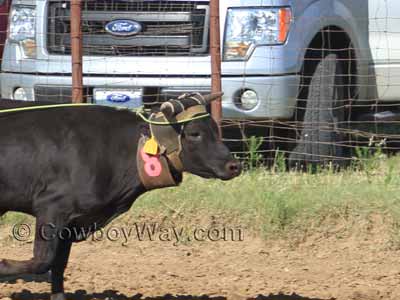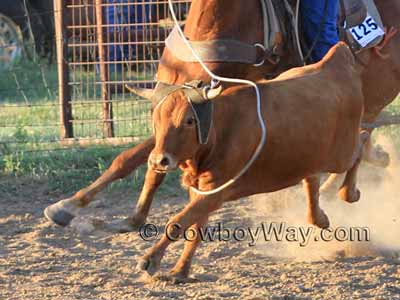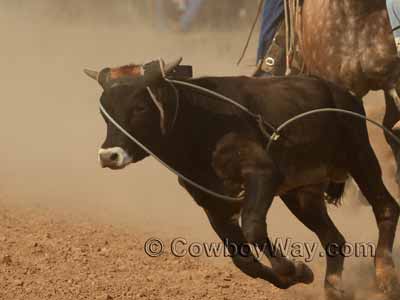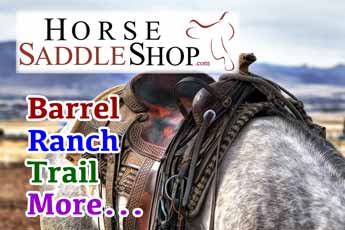What Are The Three Legal Head Catches?
In most organized team roping competitions the rules specify there are only three legal head catches.
Other roping competitions, particularly if they use cattle of a similar type and size as team roping cattle, commonly allow only the same three catches.
So, what are the three legal head catches?
- Around both horns
- A half head
- Around the neck
It's almost as straight forward as that, but not quite. For more information, please see the additional text and photos below.
Common sense warning! Rules for various roping competitions can and do vary, which means the information on this page won't apply to every situation. Always learn the rules for any particular event you may enter or watch from the event organizers.
Legal Head Catch #1 - Around Both Horns
The "around both horns" head catch is when the loop goes around and underneath the horns on both sides of the head.
This catch is also called a "horn catch," a "clean horn catch," a "slick horn catch," or something similar.
Below: An "around both horns" head catch. Notice the loop goes underneath the horns on both sides of the head.

Legal Head Catch #2 - A Half Head
A "half head" catch is when the loop goes underneath the horn on one side of the head, under the chin or neck, and on top of the horn on the other side of the head.
A half head catch is also called "half a head."
Below: A half head catch just as it's going on, without all the slack out of the loop yet.

Legal Head Catch #3 - Around The Neck
The "around the neck" catch is when the loop goes past the horns and settles around the neck.
This catch is also called a "neck" or "neck catch."
Below: An "around the neck" catch goes past the horns and settles around the neck.

When Good Loops Go Bad
There are a variety of ways a head catch can be illegal. For example:
- In each of the three legal head catches the loop has to make a clean circle around the critter's horns, half head, or neck. Put another way, the loop cannot cross itself (for example, in a figure-8 shape), or the catch is illegal.
- If the loop should pass through the critter's mouth (sometimes called a "bridle catch") the catch is illegal.
- If the honda of the rope catches on one of the critter's horns the catch is illegal.
- If the loop catches any of the legs the catch is illegal.
Below: An illegal head catch because there is a front leg in the loop.

Where The Three Legal Head Catches Don't Apply
The three legal head catches rule applies to many competitive roping events, but certainly not to all of them. Exceptions to the rule, or different sets of rules entirely, are not uncommon.
The three legal head catches rule also doesn't (necessarily) apply to roping cattle in non-competitive situations, such as in the pasture or the working pen. Whoever is in charge of overseeing the work usually has their own set of guidelines for how the cattle may be roped.
"It's All Legal In The Pasture" And
"Catch As Catch Can"
Whether it's for competition or in the pasture or working pen, two common phrases often heard when roping cattle are "It's all legal in the pasture" and "Catch as catch can."
These phrases mean that any head catch (or heel catch, for that matter) is acceptable.
However, "It's all legal in the pasture" and "Catch as catch can" shouldn't be misunderstood to mean rough treatment of the cattle is acceptable. Common sense and good cattle handling techniques are still expected to apply.
Legal Head Catches On Cattle Without Horns
As you've probably noticed, the rules for the three legal head catches applies to cattle with horns. So, what happens if the cattle are polled or dehorned?
That depends. Whether it's in competition or when working on a private cattle operation, you need to check the rules or get instructions from whoever's in charge.
However, even when roping cattle that don't have horns you sometimes still hear the phrase, "It needs to be a legal head catch," or something similar. Since the cattle don't have horns it's often assumed you'll simply figure out for yourself that since you can't catch the horns or a half head, you'll need to make a legal neck catch (#3, above).
What Is / Are...
… What Are 5 Of The Biggest Wild West Robberies?
… What Are 5 Reasons Horse Trailer Lighting Matters?
… What Are 8 Dumb Things To Say To A Horse Lover?
… What Are 9 Proven Ways To Keep Flies Off Horses?
… What Are Chestnuts and Ergots?
… What Are The Parts Of A Western Saddle?
… What Are Saddle Rigging Positions?
… What Are Some Fencing Options?
… What Are Some Foods Both Horses And Dogs Can Eat?
… What Are Some Horse Fencing Basics?
… What Are Some Interesting Horse Facts?
… What Are Some Interesting Charts and Graphs With Horse Information?
… What Are Some Options For Temporary Horse Fencing?
… What Are Synthetic Saddles Made Of?
… What Are The Rodeo Catch Pens?
… What Are The 10 Best 3-Horse Trailers With Living Quarters In The USA And Canada?
… What Are The X's In A Cowboy Hat?
… What Are The Three Legal Head Catches?
… What Is The Angle System For Branding?
… What Is The Barrel Racing Pattern?
… What Is A Bull Riding Vest Made Of?
… What Is Deworming Your Horse?
… What Is A Domain Name?
Why would I need one for my farm or ranch even if I don't have or
want a website?
… What Is A Fifth Wheel Trailer Hitch?
… What Is Flag and National Anthem Etiquette At A Rodeo?
… What Is A Slant Load Horse Trailer?
… What Is Floating A Horse's Teeth?
… What Do Horse Freeze Brands Look Like?
… What Is A Galvayne's Groove?
… What Is A Gooseneck Trailer Hitch?
… What Is Some History About The First National Finals Rodeo?
… What Is The History Of The Modern, Hornless, Bronc Riding Saddle?
… What Is The History Of The Modern Rodeo Bucking Chute?
… What Is The History Of The One-Hand Bareback Rigging?
… What Is The Nasolacrimal Duct In Horses?
… What Is A Pony Express Mochila?
… What Is Hermann Oak Leather?
… What Is Larvicidal De-Worming?
… What Is The Flehmen Response?
… What Is The Rodeo Return Gate?
… What Is A Safety Tip For Posting The Colors?
… What Is A Slick Fork Saddle?
… What Is A Swell Fork Saddle?
You Might Also Like
